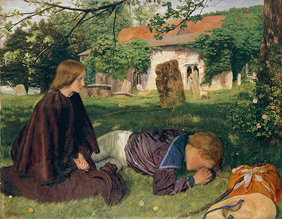The Pre-Raphaelites
dal 25/2/2009 al 23/5/2009
Segnalato da
Edward Burne-Jones
William Morris
William Holman Hunt
John Everett Millais
Dante Gabriel Rossetti
Joanna Mary Boyce
Elizabeth Siddal
Rosa Brett
Mikael Ahlund
25/2/2009
The Pre-Raphaelites
National Museum, Stockholm
The paintings of the Pre-Raphaelites shocked contemporary society and still fascinate today. The members of the group, which was active in England in the mid-19th century, turned against what they perceived as the insipid, artificial artistic ideals of the day, instead seeking earnestness and honesty in art. The exhibition shows more than 200 works from this golden age of English art. Curated by Mikael Ahlund.

curated by Mikael Ahlund
The paintings of the Pre-Raphaelites shocked contemporary society and still fascinate today. The members of the group, which was active in England in the mid-19th century, turned against what they perceived as the insipid, artificial artistic ideals of the day, instead seeking earnestness and honesty in art. And indeed, in their depictions of contemporary England they instilled a social commitment that was as radical as it was strong. Many of their paintings also show historical scenes of love, passion, life and death. In style, their work is noted for its predominantly decorative idiom, making use of brilliant, clear colours and a stylised ideal of beauty. The border between dream and reality is frequently blurred.
The members of the group described themselves as Pre-Raphaelites since they took their artistic ideals from the art of the 15th century, i.e. from the period before the Renaissance painter, Raphael. The group’s most prominent members were Dante Gabriel Rossetti, John Everett Millais and William Holman Hunt.
The exhibition shows more than 200 works from this golden age of English art.
The almost impossible name is that of a group of English artists formed in the mid 19th century. Their deeply suggestive paintings and consistent choice of serious, emotional subjects have lived on even after the group and the artists who constituted it have been forgotten.
Autumn in Bloomsbury, London. September 1848. Horizontal rain. Seven young men have gathered in a studio to form a secret brotherhood of artists. The brotherhood’s signature will be P.R.B., an abbreviation of the Pre-Raphaelite Brotherhood. The leading artists in the group are William Holman Hunt, John Everett Millais and Dante Gabriel Rossetti.
They called themselvesPre-Raphaelites. But why?
The name indicates the group’s sources of inspiration. For hundreds of years, the art establishment had based its ideas of art on the 16th-century Italian painter Raphael. The Pre-Raphaelites took their inspiration from earlier art, primarily the early Renaissance of the 15th century and medieval art. The art before Raphael. Hence the prefix Pre.
Artistic revolt
The Pre-Raphaelites wanted to change contemporary art. Inspired by medieval art and ideals, the group dealt with the eternal questions of life, love, treachery and death. The aim was to give art a higher purpose. To make it serious. They thought that the core of art lay in “what is direct and serious and heartfelt”. The paintings they created were characterised by antitheses. Their fascination with the Middle Ages was combined with strong social involvement with the now. Radical politics were combined with deep religiousness. Fantasies of times gone by met realism in detailed nature studies. Their seriousness and the meeting between reality and dreams gave the Pre-Raphaelites’ paintings a tension that shocked contemporary art critics. The same tension continues to make them interesting.
The second generation
The original brotherhood did not last long. The artists went their separate ways in life and in art. The brotherhood had been dissolved by the mid 1850s. The original member who had the most influence on the next generation of Pre-Raphaelites was Dante Gabriel Rossetti. With him and his followers, what came to be associated with the group also changed. Fantasy and dreams overcame realism. The most prominent members of the younger group were Edward Burne-Jones and William Morris.
The Pre-Raphaelite Sisterhood
The history of art has traditionally been written by men for men. This has often meant painting out female artists. But modern research has now shed new light on the Pre-Raphaelites. There were a number of women in the Pre-Raphaelite “Brotherhood”. The history books mention the sisters, models and wives. The fact is that they were active artists who made a powerful contribution to shaping the Pre-Raphaelite image world. The prominent women included Joanna Mary Boyce, Elizabeth Siddal and Rosa Brett.
The legacy of the Pre-Raphaelites
Frank Cadogan Cowper has been called the last Pre-Raphaelite. At the time of his death in 1958 there were not many people interested in his art. But this soon changed. Since the major Tate exhibition in 1984, more and more people have opened their eyes to the group’s image world in the fields of art, fashion and advertising. In the video for Nick Cave’s and Kylie Minogue’s song Where the Wild Roses Grow, Kylie lies half-drowned on the surface of the water surrounded by flowers. This scene is stronglyinspired by John Everett Millais’ painting Ophelia from 1851–52.
The photographer Tom Hunter is one of many modern artists who have been inspired by the Pre-Raphaelites. The work Home from the series Life and death in Hackney from 2000 is a modern interpretation of Arthur Hughes’ Home from Sea from 1862. One thing is obvious. Although 140 years separate the works, they both communicate the same strong feeling of grief and abandonment.
Sunday, 15 March
13.00–13.45: Mikael Ahlund, exhibition curator, presents the exhibition (in Swedish)
14.00–15.00: Lecture by English guest.
No advance bookings. Museum admission only.
Press information
Director of Information Lena Munther lmr@nationalmuseum.se
Information Officer Anna Jansson ajn@nationalmuseum.se
National Museum
Sodra Blasieholmshamnen - Stockholm



